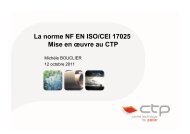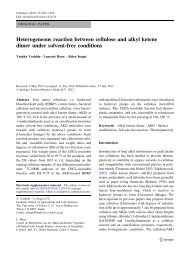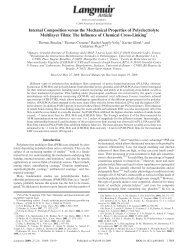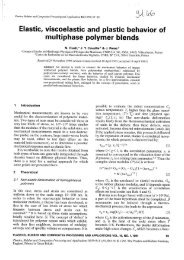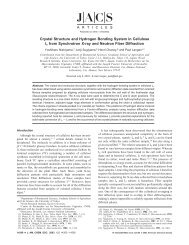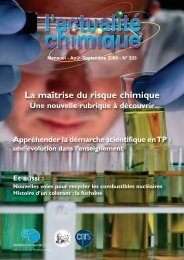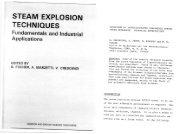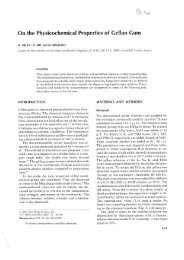Crystallography and Lectin Structure Database - CNRS
Crystallography and Lectin Structure Database - CNRS
Crystallography and Lectin Structure Database - CNRS
You also want an ePaper? Increase the reach of your titles
YUMPU automatically turns print PDFs into web optimized ePapers that Google loves.
40 U. Krengel <strong>and</strong> A. Imberty<br />
have been developed based on successful crystallization reports. These screens<br />
provide for an easy start. In general, it is recommended to start with the most<br />
common screen, Screen nr. 1, <strong>and</strong> then continue with other screens based on the<br />
obtained results. It may, however, also make sense to take the characteristics of<br />
the protein you are trying to crystallize into consideration from the very beginning.<br />
Are you working with a membrane protein? Then, you should use a screen<br />
developed for membrane proteins. Are you working with a lectin? Then, you<br />
may check out the information compiled in the BMCD at http://wwwbmcd.nist.<br />
gov:8080/bmcd/bmcd.html (searching by keyword for “lectin”). Is there a common<br />
theme? In this case, you might like to devise your own crystallization<br />
screen. Maybe, one of the proteins in the database (either the crystallization<br />
database or the PDB) has especially high sequence identity to the protein you<br />
interested in? Then, the crystallization conditions for that particular protein<br />
may pave your way to success – best of course if you combine the two<br />
approaches <strong>and</strong> try out commercial sparse matrix screens as well as your own<br />
tailor-made ones!<br />
If you are in the lucky situation that you have a dynamic or static light scattering<br />
device at h<strong>and</strong>, it can be a good idea to test how the protein behaves under<br />
different conditions (temperatures, buffers, etc.) before setting up the first crystallization<br />
experiments [121, 122]. Especially the temperature can be well worth testing.<br />
Conditions that indicate a monodisperse solution are much more likely to<br />
yield crystals than polydisperse solutions that contain various degrees of protein<br />
aggregates.<br />
The next decision to take, concerns the crystallization method. Some techniques<br />
lend themselves better to screening then others. Very suitable are methods<br />
for which multi-well plates are available (either 96-well or 24-well plates). The<br />
plates do not have to be special-made for crystallization; just usual tissue culture<br />
plates will do. Personally, we prefer to start with the hanging-drop technique shown<br />
in Fig. 8.<br />
The setups are really easy to prepare:<br />
(1) Pipette 0.5–1ml of the screening solution into the reservoir well (make sure that<br />
it is well-mixed in case of h<strong>and</strong>-made viscous solutions like PEG mixtures).<br />
(2) Grease the rim of the wells with either silicon oil (e.g. NVH oil from Hampton<br />
Research) or vacuum grease.<br />
(3) Place a clean cover slip (usually silanized) beside the plate (e.g. on the plate’s<br />
lid, which provides a convenient <strong>and</strong> clean surface).<br />
(4) Pipette first the protein solution (1–2l) onto the cover slip <strong>and</strong> then add the<br />
reservoir solution on top of it (usually the same volume) (DO NOT mix the<br />
solutions by pipetting up <strong>and</strong> down, because this can lead to protein denaturation).<br />
(5) Take the cover slip <strong>and</strong> place it upside-down onto the well with the reservoir<br />
solution.




